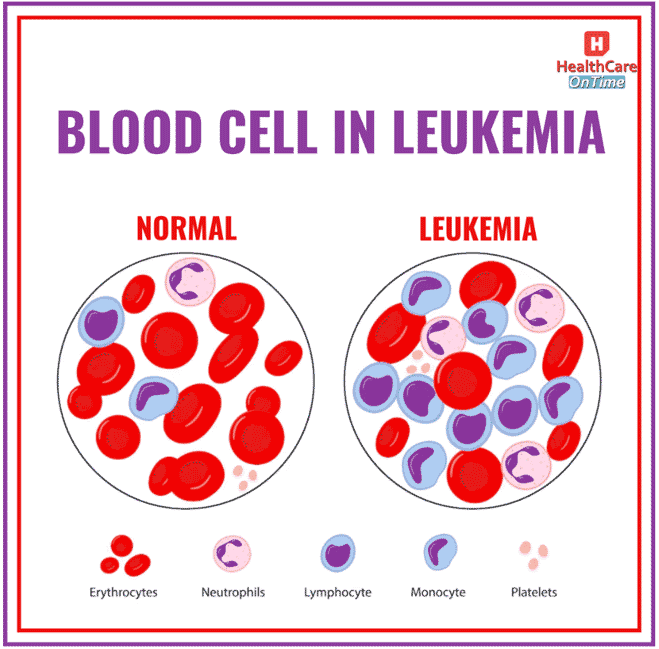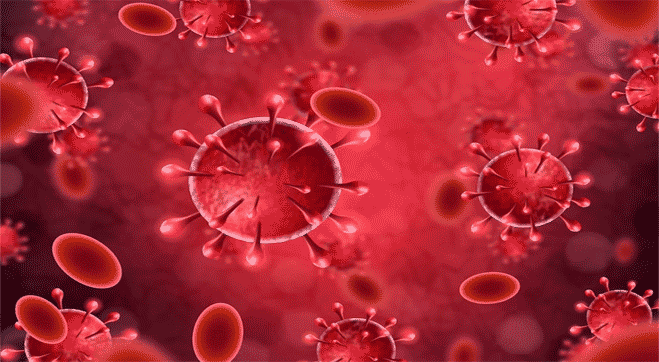What is Leukaemia?
Leukaemia blood cancer usually starts in the bone marrow and impacts the White Blood Cells (WBCs) substantially. In this condition, WBCs fail to function normally; they tend to divide too quickly, which eventually crowds the normal cells.
Normally, white blood cells play a crucial role in the body’s immune system, helping to defend against infections and diseases. In Leukaemia, however, the production of healthy white blood cells is disrupted, leading to an excess of immature or abnormal white blood cells, known as Leukaemia cells.

Did you know:
As per the latest statistics from the Indian Council of Medical Research, 20k+ new cases of leukaemia cancer were reported in 2023? In the U.S., approximately 60k+ cases are projected for 2023.
With these alarming statistics, leukaemia, a form of blood cancer, remains a pressing concern not only for India and other developing nations but for developed nations too. Watching out for the symptoms of leukaemia blood cancer, seeking on-time leukaemia diagnosis (opt for periodic CBC tests), and appropriate treatment measures can pave the way for a better quality of life.
What are the Different Types of Leukaemia and Their Survival Rates?
The types of leukaemia disease can be broadly classified into four main types based on the type of WBCs affected and the disease’s progression. Understanding these categories is crucial in assessing leukemia survival rates. Explore more about the different types, their characteristics, and the factors that impact survival rates.
- Acute Lymphocytic Leukaemia (ALL): This type of leukaemia tends to progress rapidly and affects lymphoid cells. It is more prevalent in children. The 5-year survival rate of this form of blood cancer is 69.9%. Identifying the symptoms of blood cancer readily and availing of on-time and appropriate treatment can further improve the outlook of this form of leukaemia.
- Chronic Lymphocytic Leukaemia (CLL): People aged 55 years and above are at a higher risk of developing CLL. It progresses slowly and affects mature lymphocytes, and has an 87.2% 5-year leukaemia survival rate.
- Acute Myeloid Leukaemia (AML): AML, the most common form of leukaemia, progresses rapidly and is known to affect myeloid cells. Children and young adults are more susceptible to developing this condition. AML has a 29.5% 5-year survival rate, making it one of the critical forms of leukaemia.
- Chronic Myeloid Leukaemia (CML): According to the National Cancer Institute, 9k+ cases of CML are diagnosed annually. This progresses slowly at first and may become more aggressive in the progressive leukaemia stages. It is known to affect myeloid cells and is more common in adults. The 5-year survival rate for CML is 70.6 percent.
What are the Symptoms of Leukaemia?
The signs and symptoms of leukaemia may vary based on a versatile range of factors, especially, the type and stage of the disease.
Common leukaemia blood cancer symptoms include
- Fatigue and Weakness: Fatigue and weakness are often associated with a host of health conditions. However, individuals diagnosed with leukaemia often tend to develop these symptoms during the early stages.
- Frequent Infections: WBCs are known to protect your body against bacterial, viral, fungal and other foreign substances invasions. The WBC count in the bloodstream often remains high during episodes of infections.
- Unexplained Weight Loss: This could be one of the key signs of leukaemia in adults.
- Swollen Lymph Nodes – Though WBCs are mostly produced in the bone marrow, certain WBCs can develop in the lymph nodes too. Swollen lymph nodes, especially in the neck and armpit regions, are the indicators of abnormal WBC count and functioning and thus point towards leukaemia.
- Easy bruising and bleeding
- Bone pain and joint pain
- Night sweats
- Pale skin
- Shortness of breath
Leukaemia, during its progressive stages, often impacts other body organs too, such as the lungs, GI tract, kidneys, heart and testicles. This may lead to varying symptoms of blood cancer depending on the organ being affected. Frequent headaches, nausea, vomiting, seizures and loss of muscle control can be some of the leukaemia symptoms when the central nervous system is affected by the cancer progression.
It’s essential to recognize these leukaemia symptoms early and seek medical attention promptly if they persist or worsen.
What are the Potential Causes and Risk Factors of Leukaemia:
The exact leukaemia causes are not always clear, but certain leukaemia risk factors have been identified.
The key leukaemia or blood cancer causes include:
- Exposure to radiation and certain chemicals
- Previous cancer treatment
- Certain blood disorders
- Genetic factors like Down Syndrome
How can Leukaemia be Diagnosed?
Leukaemia diagnosis involves several steps:
- Medical history and physical examination: Your primary healthcare physician will ask you about your symptoms, and medical, and family history to arrive at a preliminary diagnostic conclusion.
- Bone marrow biopsy: A sample of bone marrow is taken and examined for cancerous development.
- Imaging tests: X-rays, Pet-CT scans, or MRIs are recommended to determine the extent of the disease.
- Cytogenetic analysis: This test examines the genetic makeup of leukaemia cells to guide leukaemia treatment decisions.
- Blood tests: A CBC test can reveal abnormal levels of white blood cells, which are often associated with leukaemia. A Complete Blood Count includes RBC Blood Test, WBC Test, and platelet count test to assess blood levels. Microscopic examination detects abnormal cells. CBC aids in diagnosis, health monitoring, and treatment guidance.
What are the Recommended Treatment of Leukaemia?
The treatment depends on the type, leukaemia stage, and overall health of the patient.
Common leukaemia treatment options include:
- Chemotherapy: Powerful drugs are administered in a controlled environment to eliminate and restrict the growth of cancer cells.
- Radiation therapy: High-energy radiation beams are targeted at specific areas to destroy cancer cells.
- Stem cell transplant: Healthy stem cells from a donor are transplanted into the patient to replace damaged bone marrow.
- Targeted therapy: This treatment measures leverage drugs to specifically target cancer cells while ensuring that minimal damage is caused to healthy cells.
- Immunotherapy: Boosting the body’s immune system to recognize and attack cancer cells is at the core of immunotherapy.
Leukaemia Prevention
Prevention is better than leukaemia cure, and it involves adopting a healthy lifestyle and minimising exposure to potential risk factors.
- Avoid exposure to harmful chemicals and ionising radiation whenever possible.
- Maintain a balanced diet rich in fruits, vegetables, and whole grains to ensure essential nutrients and antioxidants.
- Adhere to a regular exercise regimen to strengthen your immune system.
Avoiding smoking and excessive alcohol consumption can help you lower the risk of leukaemia. Regular medical check-ups and early detection of any abnormalities are crucial for timely intervention. Opt for periodic CBC Test to stay vigilant about your WBC count.
Did you know:
- The normal range for white blood cell (WBC) count in the blood is 4,500 to 11,000 WBCs per microliter (4.5 to 11.0 × 10^9/L).
- Low white blood cell counts, known as leukopenia, can be caused by conditions such as bone marrow failure, leukaemia, chemotherapy, vitamin deficiency, or HIV/AIDS.
- High white blood cell counts, known as leukocytosis, can be caused by infections or inflammation.
Note From HealthcareOnTime
Leukaemia cancer is a complex and serious form of blood cancer that requires early detection and appropriate treatment for better outcomes. Knowing the symptoms and leukaemia risk factors can lead to timely leukaemia diagnosis and improved chances of successful treatment.
If you or someone you know is experiencing symptoms of leukaemia or has concerns about blood cancer, seeking prompt medical attention is crucial for a comprehensive evaluation and personalised care plan. You can opt for the CBC test done from the comfort of your home. CBC test results can offer you deep insights into your WBC profile and highlight the potential of developing blood cancer conditions. You can also leverage our Thyrocare mini health checkup package, Aarogyam Basic Or Aarogyam Advance which includes several other essential tests along with CBC tests.
We at HealthcareOnTime, the premium partners of Thyrocare, strive to offer you diagnostic tests, at-home health profile analysis, and comprehensive full-body health checkup packages for you and your family members. Stay vigilant today to lead a good quality life today and tomorrow.
Sources
Ref Links:
- https://my.clevelandclinic.org/health/diseases/4365-leukemia
- https://www.healthline.com/health/leukemia#symptoms
- https://www.mayoclinic.org/diseases-conditions/leukemia/symptoms-causes/syc-20374373









